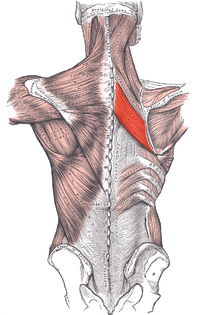Rhomboideus major muscle
| Rhomboideus major muscle |
|---|

|
| Back muscles of man |
| origin |
| Spinous processes of the 1st – 4th Thoracic vertebra , supraspinal ligament |
| approach |
| Shoulder blade , medial margin |
| function |
| Retraction of the shoulder blade |
| Innervation |
| Dorsal nerve scapulae |
| Spinal segments |
| C4-C6 |
The musculus rhomboideus major ( lat. , Literally "larger diamond-shaped muscle") is a skeletal muscle and belongs to the back muscles . The name arises from the fact that as a large rhomboid together with the small rhomboid ( rhomboid minor muscle is located), the above, a diamond forms.
The rhomboideus major muscle arises from the spinous processes of the first to fourth thoracic vertebrae and attaches to the back edge of the shoulder blade (margo medialis). It is covered by the trapezius muscle . Together with this muscle, it attaches the shoulder blade to the thorax and pulls it towards the spine.
In humans, the rhomboideus major muscle is compared to the rhomboideus minor muscle. In animal anatomy, on the other hand , the rhomboideus muscle is subdivided into a rhomboideus thoracis muscle, rhomboideus cervicis muscle and rhomboideus capitis muscle, the rhomboideus thoracis muscle corresponds to the rhomboideus major muscle.
A weakness of the musculus rhomboideus manifests itself in humans in the form of a scapula alata (angel wing), i. H. a protrusion of the medial shoulder blade edge from the rib cage.
literature
- Walther Graumann, Dieter Sasse: Compact textbook anatomy . Volume 2, Schattauer Verlag, 2004, ISBN 3-7945-2062-9 , p. 247.
- Franz-Viktor Salomon: muscle tissue. In: Anatomy for veterinary medicine. 2nd ext. Edition. Enke, Stuttgart 2008, ISBN 978-3-8304-1075-1 , pp. 147-234.